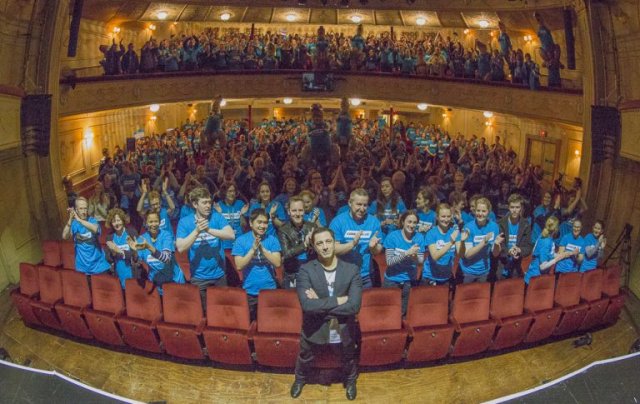
A sea of blue Allied Health Professionals burst onto the streets in the latest job walkout in a year-long industry dispute.
As part of the Code Blue action, 600 physiotherapists and radiographers, occupational therapists, speech pathologists and social planners walked off the job, holding up inflatable dinosaurs that parodied the Jurassic career structures last updated, bizarrely, in 1966.
The union coordinated stop work actions at 33 Victorian hospitals. The walk out, a prehistoric tactic itself, finally resolved the dispute, with the state government succumbing to demands and offering a 12.5% pay rise. On reaching the agreement, staff marched in celebration in city streets and country towns.
Victorian Allied Health Professionals Association (VAHPA) secretary Craig McGregor said no cars were overturned in the walk out, but the decisive victory was a rare one for unions and underlined the new strategies needed for 21st century unionism.
The pay rise was a central part of the campaign as Victorian health professionals are the lowest paid in the country. Some staff make just $2 an hour more than someone employed at a supermarket.
A speech pathologist from the 4500-member union summed up the situation well: “The pay is extremely poor in comparison to what senior staff from other professions are earning to undertake roles of similar complexity and scope.”
McGregor, who had barely slept and was still negotiating the fine print of the deal, said: “The agreement has been comprehensively rewritten, and some of the key changes include: unification of salary schedules; updating of all classification descriptors; superannuation on the employer-paid parental leave; the introduction of 20 days of paid family violence leave; and the introduction of a union matters clause granting access to paid union training.
“We are most of way there but still workload and advanced issues remain a critical issue.”
Certainly, a wage increase may do little to alleviate the risk of workload pressures in the hospital system. Still up for discussion is the scope of duties health professionals carry out each day.
Over the years, with neoliberal rationalisation, health professionals have been forced to take on more advanced functions, while also performing junior duties such as administration and reception, said McGregor. As part of the deal, advanced clinical work will only be carried out by senior staff.
Despite significantly increased productivity, management has not stopped pushing workers to the point of exhaustion — and in some cases, stress leave. Tatiana, a physiotherapist who responded to a recent survey, explained: “The pressure to keep productivity up with an increased workload, limited support and decreased staff is an irresponsible way to manage healthcare.”
Chau, an occupational therapist, said: “I have considered whether the pressure in my job, which seems to be never ending, will ultimately become too much for me and I wonder how long I can continue to place myself at risk.”
The Code Blue campaign began in 2015 when a staggering 35% of health professionals indicated they were considering leaving their current employer and 80% believed their productivity levels had increased significantly over the previous five years.
There are clearly huge problems in Victoria's public hospitals. At the same time, management was taking advantage of the way unions were representing third pillar health workers.
Following their separation from the Health Services Union in 2013, the VAHPA created a new public identity for health professionals, who traditionally “identified inwardly and discretely — for example, as medical imaging technologists, as physiotherapists, as research technologists, as social workers and as radiation therapists”.
The union was reorganised as an association for the third pillar of health care to attract a larger membership pool.
Gone are the factions and gone are leaders who had not necessarily ever worked as health professionals, says McGregor, himself a radiologist. Increasingly this is a savvy approach for unionism of the 21st century.
The soft persona of an association of workers who care deeply for cancer and other patients allows the association to be militant in negotiations with the power elite.
The victory comes on the back of an increase in members from 2000 to 4500 under McGregor's leadership — 60% of Victoria's 7500 third pillar public workers are now unionised.
Modelled on the ambulance “code red” campaign, the association used Facebook and Twitter to build a respectable and trustworthy persona, relatable to all citizens. With dense PR releases consigned to the dustbin, a focus on social media drew campaigners to post emotional messages and views of the struggle. Stickers and signs on all health vehicles asked for respect while warning of a blue emergency.
Mainstream media — especially commercial television — responded not with union-bashing but active support. “We reframed the debate”, said McGregor. “We took strike action too, and were backed by the media.
“We used modern media tools. Inserted a blue dinosaur mascot which stated that we hadn't had a new deal since 1996 — it is prehistoric.
“You can't strike; it is almost illegal, but what you can do is work on the margins with stop work actions to get results.”
Like the article? Subscribe to Green Left now! You can also like us on Facebook and follow us on Twitter.